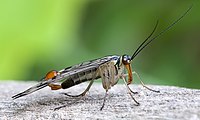
Photo from wikipedia
Hematophagous insects use heat, odors, visual cues and humidity emitted by vertebrate hosts to find them in space and time. Once they reach a host, they integrate multimodal information from… Click to show full abstract
Hematophagous insects use heat, odors, visual cues and humidity emitted by vertebrate hosts to find them in space and time. Once they reach a host, they integrate multimodal information from its skin, and decide whether to bite or not. If skin conditions fulfil the insect's expectations, it bites and pumps a small quantity of blood. Again, only if the sampled blood fulfils the insect's feeding requirements, it continues with a full ingestion. Taste is involved in both timely linked evaluation processes via contact chemoreceptors located in different parts of their bodies, driving jointly food acceptance or rejection. However, the whole picture of how blood-sucking insects evaluate the quality of a potential host is poorly understood. Here, I summarize the actual knowledge about the feeding decision-making in blood-sucking insects. Being typically involved in the transmission of diseases to humans or livestock, a deeper understanding about factors affecting an essential process as feeding in these insects could help us to find new strategies to reduce interactions.
Journal Title: Current opinion in insect science
Year Published: 2019
Link to full text (if available)
Share on Social Media: Sign Up to like & get
recommendations!